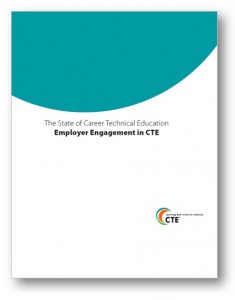Over the last month, governors around the country have gone before their state legislatures and constituents to deliver a state of the state address. A great number of this year’s state of the state addresses included proposals to expand CTE, career-readiness and expanded choices in postsecondary education. Below is the first installment of our special CTE Month roundup of state of the states as they impact CTE.
In Alabama Governor Robert Bentley announced his support for the plans laid by the Governor’s Career Ready Task Force, emphasizing the need for business and industry leaders to contribute to the conversation about what constitutes career-readiness. He advocated expanding Alabama’s dual enrollment programs and providing for more career coaches.
Governor Sean Parnell of Alaska also endorsed CTE, including proposals to expand dual enrollment programs and more CTE pathways. He commended CTE as a strategy to raise graduation rates, noting that in the Northwest Arctic Borough, introducing CTE programs led to an 11 percent increase in graduation rates.
Delaware Governor Jack Markell proposed an expansive strategy to expand CTE, beginning with a two-year comprehensive manufacturing CTE program for juniors and seniors that focuses on engineering and would lead to nationally recognized manufacturing certificates. Linked to that program, he also announced his desire to promote public-private partnerships to offer students real-world experience as part of a career-ready curriculum, and partnerships between schools and private industry to identify the programs that will best serve graduates as they enter the workforce. He touted Delaware’s JobLink program, a database designed to help employers search for jobseekers by their skills. Like Governors Bentley and Parnell, Markell also pushed for expanded dual-enrollment programs for secondary students, enabling them to earn post-secondary credit over the course of their studies.
Neil Abercrombie, Governor of Hawaii, touted his state’s investment in STEM initiatives, singling out the Thirty Meter Telescope, which features a STEM training partnership with the Institute for Astronomy’s Akamai Workforce Initiative to train postsecondary students in STEM and robotics.
Kentucky Governor Steve Beshear lauded the state’s progress in CTE. He cited “…a new model of secondary career and technical education to make it more accessible to students at an earlier age, more rigorous academically and better aligned with both postsecondary requirements and employer needs…We are fitting the pieces together to create a seamless, cradle-to-career education system that is better preparing our students for this complex world.”
North Carolina Governor Pat McCrory outlined the importance of ensuring that secondary and postsecondary pathways for success include all types of postsecondary credential—certificates, associates degrees and professional certification—as well as four-year degrees. Governor McRory also conveyed his support for helping private sector professionals transition into teaching, opening the door for experts in technical fields to begin careers as CTE teachers.
In his State of the State Address, Governor Earl Ray Tomblin of West Virginia expressed his belief that CTE can be a critical tool for students who wish to pursue STEM at the postsecondary level. He cited West Virginia’s work to bring math and language arts teachers into career and technical schools, thereby minimizing the need to bus students to and from CTE and comprehensive schools. Governor Tomblin also highlighted the Advanced Careers Program (ACP), pointing out five CTE sites that have instituted career courses as a result of the ACP program, and stated that the program would help 32 sites to implement high quality CTE programs by 2016.
These governors proposed action to unlock CTE’s potential to help students, improve workforce quality and boost economic development. Be sure to visit the links above for the full text of each governor’s address. Don’t see your state? Keep an eye on the CTE Blog for part two of our state of the states roundup!
– Evan Williamson, Communications Associate
 with the CTE enterprise to help prepare students for success in careers.
with the CTE enterprise to help prepare students for success in careers.

 activity as it relates to Career Technical Education (CTE). Further explanation of the series can be found
activity as it relates to Career Technical Education (CTE). Further explanation of the series can be found